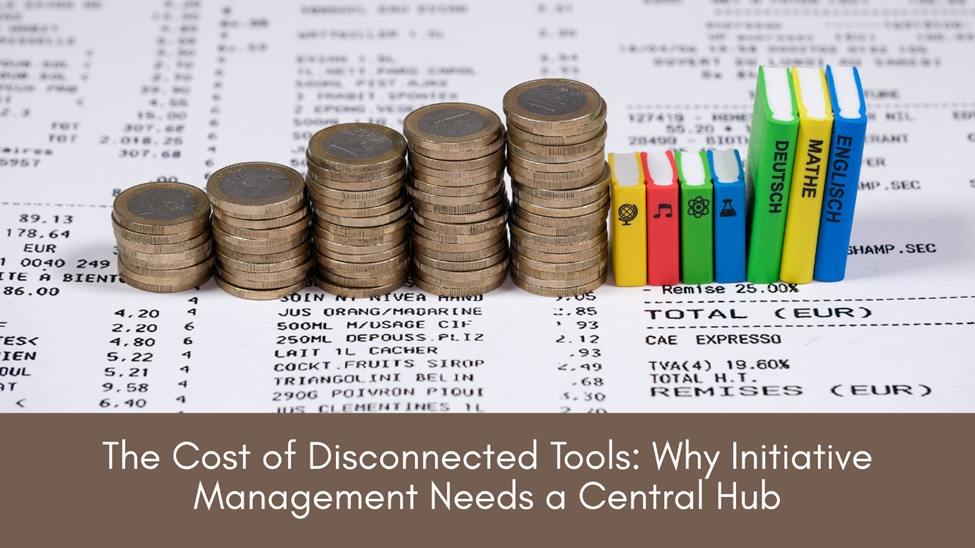
In today’s enterprise landscape, initiatives drive transformation, growth, and innovation. Whether it’s launching a new product, migrating to the cloud, or optimizing operations, success hinges on execution.
Yet, many organizations still rely on a patchwork of disconnected tools — spreadsheets for planning, email for updates, shared drives for documents, and various project management apps for tracking.
On the surface, this may seem harmless. But in reality, tool fragmentation silently drains efficiency, budget, and morale. The true cost is far greater than many leaders realize.
This blog will explore:
- The hidden costs of disconnected tools in initiative management
- How fragmented systems erode visibility, collaboration, and accountability
- Why a central hub is no longer optional but essential for modern execution
- How solutions like Whizible empower enterprises to align strategy and delivery seamlessly
The Hidden Costs of Disconnected Tools
1. Wasted Time on Manual Coordination
When tools don’t talk to each other, your teams spend countless hours reconciling data, duplicating updates, and chasing status reports.
Instead of focusing on delivering outcomes, they’re stuck in “admin mode.”
- Example: A PMO lead spends 8 hours a week updating multiple reports because Jira data doesn’t sync with the executive dashboard.
- Impact: Missed deadlines, late escalations, and team frustration.
Data point: According to McKinsey, employees spend 19% of their workweek searching for and gathering information — a direct byproduct of disconnected systems.
2. Inconsistent and Outdated Data
If updates are scattered across tools, no one has a single source of truth. Decision-makers rely on stale or conflicting data, making it harder to course-correct in time.
- Scenario: Marketing sees a 70% completion rate on a campaign, while Operations’ tool shows only 50% — who’s right?
- Result: Delayed actions, duplicated efforts, and avoidable mistakes.
3. Missed Risks and Escalations
Without centralized visibility, early warning signs are often missed.
Issues like scope creep, budget overruns, or resource bottlenecks remain hidden until it’s too late.
- In a central hub like Whizible’s real-time governance dashboard, leaders can detect risk patterns early and intervene before escalation.
4. Higher Tool and Training Costs
Maintaining multiple platforms means paying for multiple licenses, integrations, and ongoing training.
Beyond cost, the learning curve slows adoption and creates uneven expertise across teams.
Why Fragmented Tools Break Initiative Management
Initiative management is not just about tracking tasks. It’s about orchestrating strategy, people, and processes toward a shared outcome.
Fragmented tools break this orchestration in three critical ways:
1. Strategy Loses Connection to Execution
Boardroom strategies often fail because they don’t translate into clear, trackable execution plans across teams.
Disconnected tools widen this gap, turning ambitious goals into uncoordinated efforts.
2. Collaboration Becomes Reactive
In a fragmented environment, collaboration happens reactively — via last-minute status calls, email chains, and urgent chats — instead of proactively with shared visibility.
3. Accountability Becomes Blurry
When data lives in silos, it’s harder to assign ownership. Teams can shift blame, or worse, critical dependencies get overlooked.
The Case for a Central Hub in Initiative Management
A central hub is a unified platform where all initiative-related activities — planning, tracking, collaboration, and reporting — live in one place.
This approach delivers five transformative benefits:
1. Single Source of Truth
No more conflicting reports or outdated spreadsheets. Everyone works from the same, real-time data.
- In Whizible, initiative progress, resource allocation, and risk alerts are visible to all stakeholders in one dashboard.
2. Seamless Cross-Functional Collaboration
With integrated workflows, Marketing, IT, Finance, and Operations stay aligned without switching tools.
3. Real-Time Governance and Early Risk Detection
Leaders can spot bottlenecks, budget overruns, and missed milestones before they spiral — reducing firefighting and improving delivery predictability.
Learn more about Whizible’s real-time governance features.
4. Optimized Resource Utilization
By unifying initiative and resource data, leaders can allocate the right skills to the right projects at the right time.
Related reading: Utilization Without Burnout: The Secret to Smarter Resource Allocation in IT Projects.
5. Lower Costs, Higher ROI
One central hub replaces multiple licenses, reduces training overhead, and accelerates adoption — delivering better ROI from both tools and talent.
Why Whizible is Built as a Central Hub
Whizible isn’t just another project tool. It’s a Project Services Automation (PSA) platform designed for complex, multi-initiative environments.
It integrates:
- Strategy-to-execution alignment
- Multi-methodology project planning (Agile, Waterfall, Hybrid)
- Resource, cost, and revenue management
- Real-time analytics and governance
- Automated reporting for executives and delivery teams
By becoming the “operating system” for service delivery, Whizible ensures that initiatives don’t just start strong — they finish strong.
Transitioning from Disconnected Tools to a Central Hub
Here’s how organizations can make the shift effectively:
1. Audit Your Current Tool Stack
Identify overlapping features, integration gaps, and the cost of maintaining multiple platforms.
2. Define Your Central Hub Requirements
Look for:
- Real-time visibility
- Integration with existing systems
- Role-based dashboards
- End-to-end process coverage
3. Migrate in Phases
Start with critical initiatives, then expand. Use change management strategies to drive adoption.
4. Train for Value, Not Just Features
Focus training on how the hub improves outcomes, not just how to click buttons.
Final Thoughts — Centralization Is No Longer Optional
Disconnected tools are more than a nuisance — they’re a hidden tax on your initiatives.
They erode alignment, waste resources, and delay results.
In an environment where speed, adaptability, and visibility define competitive advantage, a central hub for initiative management is no longer a nice-to-have.
Platforms like Whizible don’t just centralize tools — they centralize outcomes, ensuring every initiative stays connected from boardroom to execution floor.
🚀 Ready to connect your initiatives in one central hub? Book a personalized Whizible walkthrough today and see how unified execution transforms results.
👉 Book a personalized demo now : https://calendly.com/vishw/30min/invitees
📥 Learn more about features, benefits, and use cases at:
👉 www.initiatives.app
Contact Us : info@whizible.com | +91 855-498-3315
Address : Mrugank, Level 3, Kothrud, Pune, Maharashtra, 411038